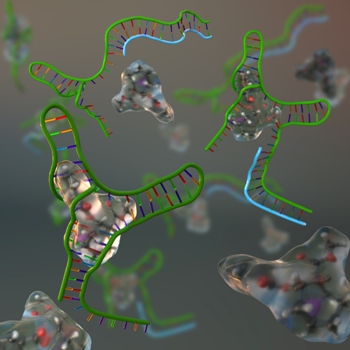Feb 15 2013
Since the beginning of time, living organisms have developed ingenious mechanisms to monitor their environment. As part of an international study, a team of researchers has adapted some of these natural mechanisms to detect specific molecules such as cocaine more accurately and quickly. Their work may greatly facilitate the rapid screening—less than five minutes—of many drugs, infectious diseases, and cancers.
 Artist’s rendering: The research team used an existing cocaine biosensor (in green) and revised its design to react to a series of inhibitor molecules (in blue). They were able to adapt the biosensor to respond optimally even within a large concentration window. (University of Montreal)
Artist’s rendering: The research team used an existing cocaine biosensor (in green) and revised its design to react to a series of inhibitor molecules (in blue). They were able to adapt the biosensor to respond optimally even within a large concentration window. (University of Montreal)
Professor Alexis Vallée-Bélisle of the University of Montreal Department of Chemistry has worked with Professor Francesco Ricci of the University of Rome Tor Vergata and Professor Kevin W. Plaxco of the University of California at Santa Barbara to improve a new biosensing nanotechnology. The results of the study were recently published in the Journal of American Chemical Society (JACS).
Toward a new generation of screening tests
"Nature is a continuing source of inspiration for developing new technologies,” says Professor Francesco Ricci, senior author of the study. “Many scientists are currently working to develop biosensor technology to detect—directly in the bloodstream and in seconds—drug, disease, and cancer molecules."
“The most recent rapid and easy-to-use biosensors developed by scientists to determine the levels of various molecules such as drugs and disease markers in the blood only do so when the molecule is present in a certain concentration, called the concentration window,” adds Professor Vallée-Bélisle. "Below or above this window, current biosensors lose much of their accuracy.”
To overcome this limitation, the international team looked at nature: “In cells, living organisms often use inhibitor or activator molecules to automatically program the sensitivity of their receptors (sensors), which are able to identify the precise amount of thousand of molecules in seconds,” explains Professor Vallée-Bélisle. “We therefore decided to adapt these inhibition, activation, and sequestration mechanisms to improve the efficiency of artificial biosensors.”
The researchers put their idea to the test by using an existing cocaine biosensor and revising its design so that it would respond to a series of inhibitor molecules. They were able to adapt the biosensor to respond optimally even with a large concentration window. “What is fascinating,” says Alessandro Porchetta, a doctoral student at the University of Rome, “is that we were successful in controlling the interactions of this system by mimicking mechanisms that occur naturally.”
“Besides the obvious applications in biosensor design, I think this work will pave the way for important applications related to the administration of cancer-targeting drugs, an area of increasing importance," says Professor Kevin Plaxco. “The ability to accurately regulate biosensor or nanomachine’s activities will greatly increase their efficiency.”
References on the study
The research was funded by the Italian Ministry of Universities and Research (MIUR), the Bill & Melinda Gates Foundation Grand Challenges Explorations program, the European Commission Marie Curie Actions program, the U.S. National Institutes of Health, and the Fonds de recherche du Québec Nature et Technologies.